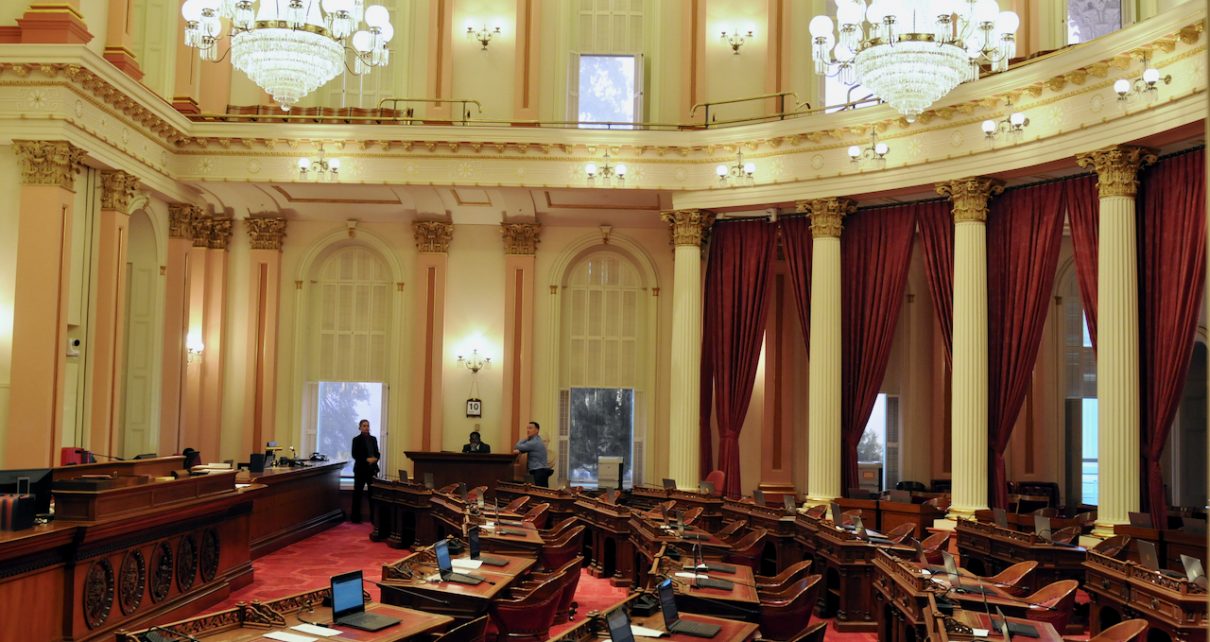
California Senate Chambers. (Photo: Kevin Sanders for California Globe)
Guidelines for Drafting Legislative Statements in Bills
A legislative intent statement often includes a statement of the desired result
By Chris Micheli, February 19, 2023 9:09 am
There are differences between legislative findings and declarations and statements of legislative intent, and the bill drafter needs to be aware of these. The Colorado Bill Drafting Manual states: “A legislative declaration statement is an explicit or formal statement or announcement about the legislation. A legislative intent statement indicates the intended purpose or aim of the legislation or it may indicate the state of mind of the legislature at the time it is enacting the measure.”
Findings and declarations, such as those used in California legislation, may provide factual information or value statements about the subject addressed in the bill, or describe the problem the Legislature is trying to address. A legislative intent statement often includes a statement of the desired result.
In writing either of these statements, the bill drafter should evaluate the purpose for inclusion of a legislative finding or declaration statement or a legislative intent statement. In some instances, these statements may be better saved for the bill fact sheet committee bill analysis, rather than be included in the bill. While the bill’s author can choose whether or not to include these statements in the bill, the drafter should ensure the accuracy of the statements. The drafter also needs to determine with the bill author whether to codify these statements or not.
Legislative findings and declarations can establish a historical or factual basis to explain the enactment of the bill. Of course, these statements must be accurate. They can also be helpful when expecting a legal challenge to the legislation because courts often consider these official statements of the Legislature.
Legislative intent statements are likewise important for providing an explanation to the general public, the regulated community, the executive branch, or the judicial branch. As we know from statutory interpretation principles, whether the courts consider legislative declarations or legislative intent statements is based upon whether there is ambiguity in the statute. The reason that some states frown on the use of these statements is because they believe unambiguously drafted statutes do not need these types of statements.
Because the courts only look to the legislative declaration or intent statement if a statute is ambiguous, they are used to construe the scope and effect of a statute. These statements or declarations do not confer power or determine rights under the law, so drafters should ensure that they cannot be viewed as creating a substantive right or a promise that the state will do something, like fund a program.
As the Colorado Bill Drafting Manual explains, “A legislative declaration or legislative intent statement should serve a legitimate purpose. Statements that serve other purposes should be avoided.” Colorado’s Manual also points out that “a statement should not be characterized as ‘legislative intent’ when it really is a ‘legislative declaration’ and vice versa.”
When drafting either of these statements, the drafter should ensure that they accurately reflect the contents of the bill. In addition, there should be logical connection between the desired result and the reasons stated in the statement. Decide what the purpose of the statement is to be and then make the words accomplish the purpose.
In many instances, bill authors are given free rein to draft their findings and declarations. However, most states encourage bill drafters to verify statements for accuracy. If courts are to rely upon these statements, then they need to be correct. In fact, at least one trial court in California looked behind the statements contained in a bill and found them not to be accurate and therefore disregarded them for purposes of interpreting the bill.
In addition, these declarations and statements should not be ambiguous. They should be clear and concise statements. Of course, that goes for the bill itself. A legislative intent statement should not be a substitute for precise and accurate legislative bill drafting.
As discussed above, a legislative finding or declaration or a legislative intent statement should not create any kind of right or prohibit any type of action. In other words, these statements are not to create substantive law. That is left to the statutory provisions of the bill. A legislative declaration or a legislative statement should not be written unless there is a legitimate reason for its inclusion.
- Modifying or Terminating Child Support Orders - December 17, 2025
- Procedures for Adult Adoptions - December 17, 2025
- Quiz on Where Areas of Law Are Found in the California Codes - December 16, 2025





3 thoughts on “Guidelines for Drafting Legislative Statements in Bills”